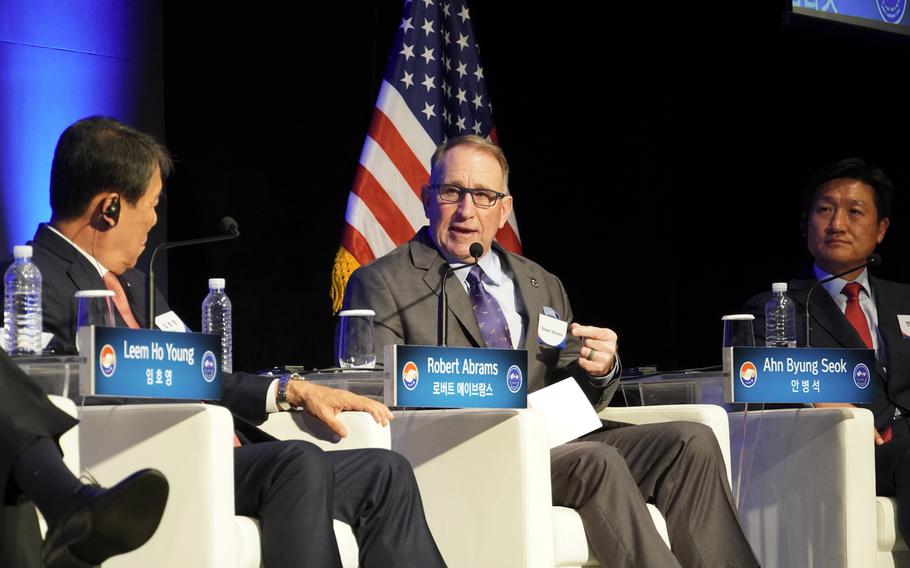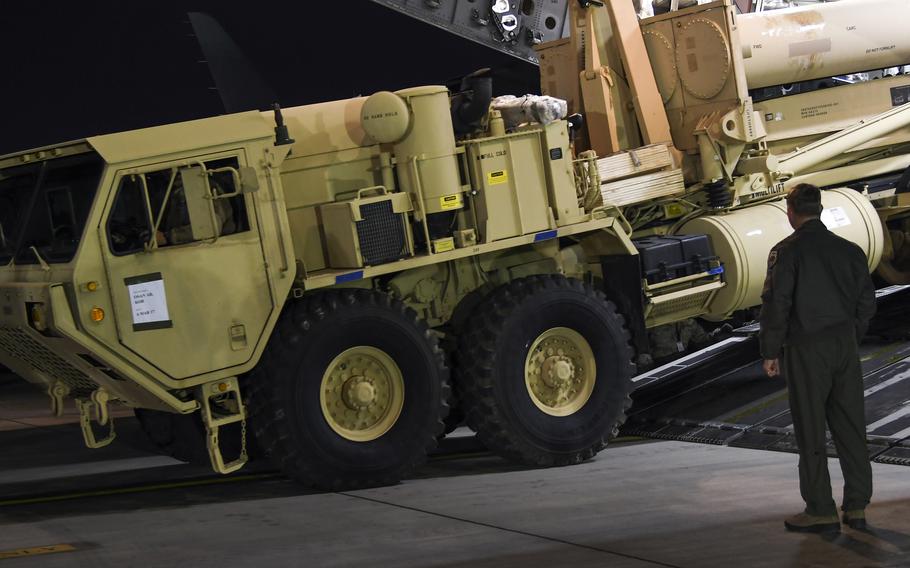
Retired U.S. Army Gen. Robert Abrams, the former commander of U.S. Forces Korea, speaks on panel alongside retired South Korean Gens. Leem Ho Young and Ahn Byung Seok in Seoul, South Korea, Oct. 30, 2024. (David Choi/Stars and Stripes)
SEOUL, South Korea — The former commander of U.S. troops in South Korea delivered a stark warning this week about China’s ability to weaponize its economic influence over South Korea.
Beijing is the “principal driver of instability” within the region, retired Army Gen. Robert Abrams, the former commander of U.S. Forces Korea, U.N. Command and Combined Forces Command, said Wednesday at a roundtable discussion. He was joined by two of his predecessors, retired Army Gens. Walter Sharp and Curtis Scaparrotti, and three retired South Korean generals.
Abrams warned of threats posed by China during the event hosted by the Ministry of Patriots and Veterans Affairs, Korea-U.S. Alliance Foundation and the Korea Defense Veterans Association.
“It’s my assessment that a lot of people just aren’t paying attention or are sort of numb to what’s going on,” he told an audience of about 350 U.S. and South Korean service members. “You don’t have to look any further than the Korean Peninsula to see signs of this strategic competition.”
The former four-star general commanded approximately 28,500 U.S. troops in South Korea from 2018 to 2021 before retiring after 39 years of service.
A year before Abrams took command on the peninsula, South Korea’s government approved a U.S. Terminal High Altitude Area Defense system, or THAAD, for a South Korean military base in Seongju, about 130 miles south of Seoul.
U.S. and South Korea publicly assured China, one of North Korea’s closest allies, that stationing the defensive system was a response to the threat posed by the North’s ballistic missiles. China opposed the deployment as a threat to its regional interest.

A Terminal High Altitude Area Defense, or THAAD, battery is unloaded at Osan Air Base, South Korea, March 6, 2017. (U.S. Air Force)
In response, Beijing imposed a broad, state-sanctioned boycott against South Korean businesses following the THAAD’s arrival in 2017, leading to revenue losses of approximately $7 billion, South Korean lawmakers alleged at the time.
The $800 million system developed by Lockheed Martin fires missiles to intercept and destroy incoming ballistic missiles up to 125 miles away by colliding with them rather than exploding near them.
North Korea has fired more than 40 ballistic missiles in 11 separate days of testing so far this year. On Thursday, it launched an intercontinental ballistic missile that flew approximately 620 miles before splashing down in the Sea of Japan, or East Sea, according to the South’s military.
“For six years, China punished and issued many veiled threats to [South Korea] because they approved the deployment … despite numerous explanations of the defensive nature of THAAD and its radar,” Abrams said. “What should be most upsetting to the Koreans that are in the room is that deploying THAAD, that was not a U.S. decision.”
Abrams described China’s boycott as an “economic chokehold” and warned Beijing could re-impose it.
“That’s what should bother you,” he said. “[China] can do it again at their will.”
China is South Korea’s largest trading partner with nearly $270 billion in trade last year, followed by the U.S. with almost $190 billion, according to a Korea International Trade Association report in February.
A separate trade association study published in February reported South Korea’s exports to China last year dropped to the lowest levels since 1992.
“Anyone who thinks that Korea is somehow immune to Chinese subterfuge — their misbehavior, their designs — they need to pay much closer attention to what’s been happening here in Northeast Asia for the last five years,” Abrams said.